Scanning the Past: A History of Electrical Engineering from the Past
Submitted by Marc Bell, Editor
Copyright 1997 IEEE. Reprinted with permission from the IEEE publication, “Scanning the Past” which covers a reprint of an article appearing in the Proceedings of the IEEE Vol. 85, No. 9, September 1997.
Ralph Bown and the Golden Age of Propagation Research
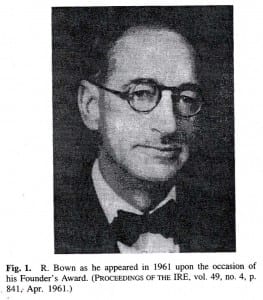 Sixty years ago this month, the PROCEEDINGS OF THE INSTITUTE OF RADIO ENGINEERS (IRE) included a paper by R. Bown (Fig. 1) on the development of transoceanic radiotelephony. At the time, he was director of radio research at the Bell Telephone Laboratories. Bown already had served as president of the IRE and was a future recipient of the IRE Medal of Honor. He was a leader in the collection and analysis of wave propagation data as the useful radio spectrum expanded to include shorter wavelengths after World War I.
Sixty years ago this month, the PROCEEDINGS OF THE INSTITUTE OF RADIO ENGINEERS (IRE) included a paper by R. Bown (Fig. 1) on the development of transoceanic radiotelephony. At the time, he was director of radio research at the Bell Telephone Laboratories. Bown already had served as president of the IRE and was a future recipient of the IRE Medal of Honor. He was a leader in the collection and analysis of wave propagation data as the useful radio spectrum expanded to include shorter wavelengths after World War I.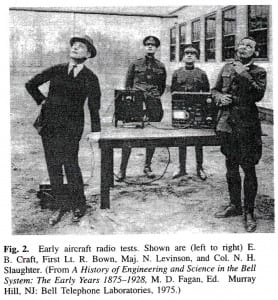
Bown was born in Fairport, NY, in 1891 and graduated in engineering from Cornell University in 1913. He continued his education at Cornell, where he received the master’s degree in 1915 and the Ph.D. degree in 1917. He served as a physics instructor while completing his graduate studies and was an officer in the U.S. Army Signal Corps (Fig. 2) during 1917-1919. He joined the development and research department of the American Telephone and Telegraph Company in New York City in 1919, where he worked until 1934.
Bown and several colleagues were active participants in what has been characterized as the “golden era” of propagation investigations in the 1920’s. They used recording oscillographs and other instruments to monitor wave propagation over time and over a wide range of frequencies. They introduced multiple-unit antennas as a way to minimize fading and determined that speech-to-noise ratio was more useful than simply measuring field strengths from remote transmitters. They developed specifications for the design of transmitters and receivers to minimize cost while achieving adequate quality for commercial communication over transoceanic distances. Early findings were included in an April 1923 PROCEEDINGS paper entitled “Radio Transmission Measurements” by Bown and two coauthors, C. R. Englund and H. T. Friis (Figs. 3-5). Bown also coauthored two papers concerning radio broadcast propagation for the PROCEEDINGS of August 1924 and February 1926. Bown was elected a fellow of the IRE in 1925 and received the Morris N. Liebmann Memorial Award from the IRE in 1926 in recognition of his contributions to greater understanding of propagation phenomena. He was elected president of the IRE in 1927.
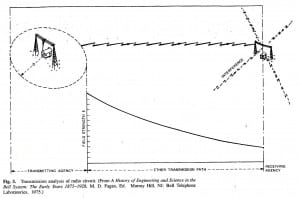 In 1934, Bown joined the staff of Bell Telephone Laboratories, where he directed research on radio and television. He was appointed to the Microwave Committee of the National Defense Research Committee in fall 1940 and was involved in the decision to create the legendary Radiation Laboratory at the
In 1934, Bown joined the staff of Bell Telephone Laboratories, where he directed research on radio and television. He was appointed to the Microwave Committee of the National Defense Research Committee in fall 1940 and was involved in the decision to create the legendary Radiation Laboratory at the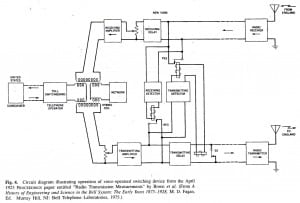 Massachusetts Institute of Technology. He insisted that research on microwave propagation be emphasized at the new laboratory. He served as a consultant to the U.S. secretary of war and helped define the mission of the Radio Research Laboratory established at Harvard University to develop electronic counter-measures equipment and techniques. A proposal that he made to enhance the performance of a navy ship borne radar against low-flying aircraft was adopted and proved successful.
Massachusetts Institute of Technology. He insisted that research on microwave propagation be emphasized at the new laboratory. He served as a consultant to the U.S. secretary of war and helped define the mission of the Radio Research Laboratory established at Harvard University to develop electronic counter-measures equipment and techniques. A proposal that he made to enhance the performance of a navy ship borne radar against low-flying aircraft was adopted and proved successful.
Bown became director of research at Bell Labs in 1946, a position he held until 1951. He then served as a vice president until his retirement in 1956. He authored a paper in 1955 in which he gave his personal perspective on the research effort that had led to the invention of the transistor in 1947. 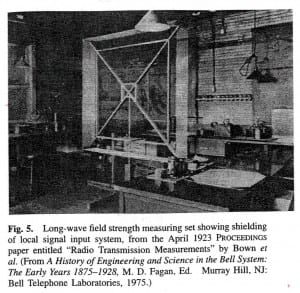 The IRE awarded him its prestigious Medal of Honor in 1949 as recognition for both his technical contributions and his dedicated service to the IRE. Subsequently, he received the Founders Medal from the IRE in 1961. Bown died in July 1971 at age 80.
The IRE awarded him its prestigious Medal of Honor in 1949 as recognition for both his technical contributions and his dedicated service to the IRE. Subsequently, he received the Founders Medal from the IRE in 1961. Bown died in July 1971 at age 80.
James E. Brittain
